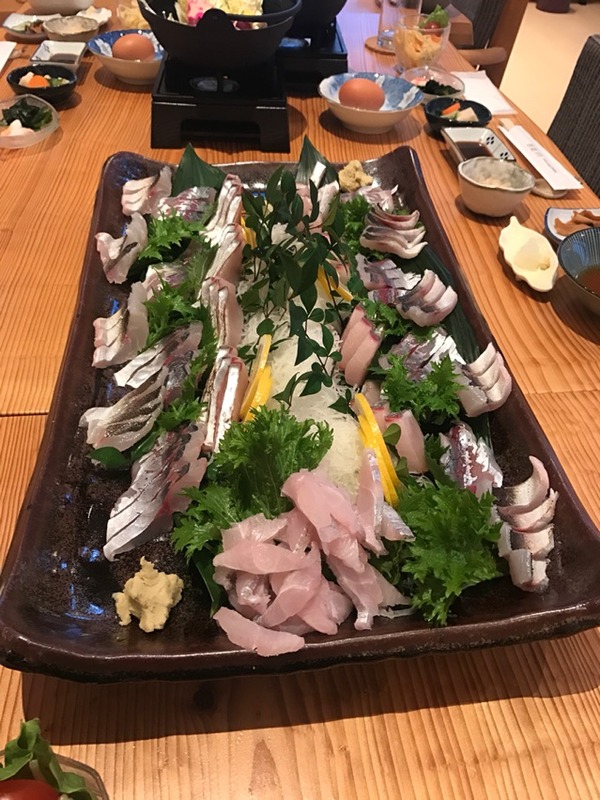At the moment, Ojika is not a popular travel destination for foreigners. While its tourism industry serves Japanese travellers easily, it is only beginning to expand towards attracting English-speaking guests. I’m always looking for opportunities to live like a local when I travel, so I’m grateful to have stumbled across Ojika on the internet. During my first day on the island, I was surprised to find how well the town preserves its history. Most of the buildings and homes haven’t been renovated. It’s amazing to see so many old, traditional Japanese houses. In a small coffee shop on the main shopping street, I felt like I had stepped back into time. I’ve always wanted to time travel to the past, and Ojika, in some ways, gives me a taste of what it would be like. While walking around town in the Fuefuki shopping area near the harbor, the sun was shining, there was a perfect breeze, and everyone greeted me or smiled as I passed. The positivity is palpable in the atmosphere.
At Goen, the food is incredible. The fish in Ojika is probably some of the best in the world… So dinner at Goen is very “oishii” (delicious.) I can’t wait to eat more of the food and explore the island. Taiyo, the owner of the inn, showed me a bunch of places on the map where I can go, like a red sand beach and a mysterious “pot hole.” One of the main attractions nearby is Nozaki Island, a deserted island where Christianity once thrived in secret while it was forbidden in Japan. The last resident finally left a few years ago, and it’s set to become a UNESCO World Heritage site soon. I look forward to seeing everything!
#2 Biking, Day One!
I got an English-language map of the island from Goen and marked the places I wanted to go. I first went to Eidan, a grocery store, to pick up some sweets. I tried to buy mochi, which are sweet rice cakes and my favorite Japanese treat, but I can’t read Japanese and accidentally bought some red-bean filled marshmallows... They were also tasty, though!
Once I got to the top, I walked around, laid down in the grass, and took some photos of the nice blue-and-green view. Then, I got back on the bike and prepared myself for the descent. I squeezed the brakes as hard as I could, but it made a terrible screeching noise -- sorry Ojika neighbors! -- and I flew down the hill. I really felt the wind blowing through my hair this time!
#3 Biking, Day Two!
I dipped my toes in the water to test it, but it’s too cold now (in early June) to swim. When I was leaving, I saw someone bringing a SUP board -- I’d love to do SUP here! The water is calm and beautifully clear.
Next, I went to Goryodaki, which is nearby Kakinohama. This tiny beach set into a large cliff is one of the most naturally stunning sights I’ve seen in the world.
The sky was clear blue (as it often is here,) the water was sparkling with the reflection of the sun, and the green grass completed the colorful image. I took so many videos as I climbed over the black rocks in the sand and onto the grassy hills.
In other incredible “sightseeing” spots around the world, there are crowds of tourists. Today, at Kakinohama and Goryodaki, I was the only person there. Tourist spots with high traffic inevitably diminish the quality of the nature overtime… Luckily Ojika doesn’t have that problem.
On my way back towards Goen, I decided to forgo the map and take some of the small roads and paths around the island. There’s a lot of farmland and rice fields, and I wanted to venture off of the main road. I found cows!
#4 Sushi and Sunshine
There were all different kinds of fish, and I ate so fast. Once I was starting to feel full, we were given another big plate of sushi. This time, they were vegetarian makis (rolls) and the yummy ones with tofu skin. I was definitely full.
After lunch, Hiroko took me to a nearby house that has old Japanese objects on display inside. When I walked in, a woman told me in English, “old Japanese things!” Of course I couldn’t read any of the plaques for the objects, but Hiroko and her friend Ryoko translated some things for me. There was a section upstairs with artifacts from World War II and old journals from schoolkids. Besides the objects, the house itself, like nearly all of the houses on Ojika, was in its original state. Built of stone, wood, and natural materials, the houses give Ojika a special, old-fashioned feeling. It’s clear that the island and its people value nature and don’t care about materialism or ostentation. Three women were sitting on the floor at a Japanese-style low-to-the-ground table, watching old home videos of the traditional dances that they used to perform when they were younger. They were having a good time watching their younger selves on the screen and eating fresh fruit. The lifestyle on the island is calm and relaxed. No one seems to be stressed or angry or worried.
In the evening, Hiroko drove me and Ryoko to Madera Island, which is connected to Ojika by a short bridge. We stopped at the “Tori” gate, and Hiroko took photos of me. She documents every day with her camera. There’s a “pot hole” here that has been formed over thousands of years. Apparently it’s the second largest in the world. There’s a giant stone inside the hole. It’s kind of freaky. How did it get in there? The area around the pot hole is really beautiful, too, especially as the sun was beginning to set. (Do you notice a pattern? Everywhere in Ojika is beautiful…)






No comments:
Post a Comment